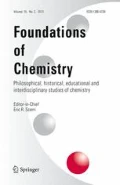ABSTRACT
The project of chemistry to classify substances and develop techniques for their transformation into other substances rests on assumptions about the means by which compounds are constituted and reconstituted. Robert Boyle not only proposed empirical tests for a metaphysics of material corpuscules, but also a principle for designing experimental procedures in line with that metaphysics. Later chemists added activity concepts to the repertoire. The logic of activity explanations in modern times involves hierarchies of activity concepts, transitions between levels through non-dispositional groundings. Such hierarchies terminate in powerful particulars, such as elementary charged particles. Do these have a fundamental place in the most recent accounts of molecular architecture, stabilities and transformations? However, a close study of the contemporary chemistry of substances transforming reactions discloses a hybrid metaphysics, making use of both the Boylean corpuscles and Faradayan fields. This is illustrated by an analysis of the metaphysics inherent in John Polanyi’s use of “chemoluminescence” to follow the formation of products in chemical reactions. A brief sketch of a resolution of the tension between the two metaphysical schemes is drawn from Niels Bohr’s radical metaphysics extended from the quantum realm proper to chemistry (and perhaps beyond).
Similar content being viewed by others
References
Atkins P.W. (1998) Physical Chemistry. Oxford University Press, Oxford
Berkson W. (1974) Fields of Force. Routledge and Kegan Paul, London
Boscovich R.J. (1763). [1922] A Theory of Natural Philosophy. Trans. J. M. Child. Open Court, Chicago
Boyle R. (1666) The Origins of Forms and Qualities. Davis, Oxford
Brock S. (2004) Niels Bohr’s Philosophy of Quantum Physics. Logos Verlag, Berlin
Davy H. (1839–40). Collected Works. Ed. J. Davy, London
H. Davy. Elements of Chemical Philosophy, (Alembic Club Reprints #6) Edinburgh: The Alembic Club, (1935) 1812
J. Earley. ‘Why there is no salt in the sea’ Foundations of Chemistry, 7, pp. 31–49. 2004
Faraday M. (1839 – 1855). [1912] Experimental Researches. Dent, London
W. Gilbert. [1600] De magnete. London
Kant I. (1786). [1970] The Metaphysical Foundations of Natural Science. Trans. J. Ellington. Bobbs-Merrill, Indianapolis
Knight D. (1970) Atoms and Elements. Hutchinson, London
Levere T.H. (1971) Affinity and Matter. Clarendon Press, Oxford
Newton I. (1713). [1952] Opticks. Dover Books, New York
Polanyi J.C. (1972) ‘Chemical kinetics’. In: Polanyi J.C. (eds). Physical Chemistry Series One, Vol. 9, Butterworth, London
Science.ca Team. Profile: John Charles Polanyi, GSC Research Society. http://www.science.ca, 2001
J.C. Polanyi. Reaction dynamics. Science Vol. 234
Author information
Authors and Affiliations
Corresponding author
Rights and permissions
About this article
Cite this article
HARRÉ, R. SOME PRESUPPOSITIONS IN THE METAPHYSICS OF CHEMICAL REACTIONS. Found Chem 10, 19–38 (2008). https://doi.org/10.1007/s10698-005-9000-8
Received:
Accepted:
Published:
Issue Date:
DOI: https://doi.org/10.1007/s10698-005-9000-8




